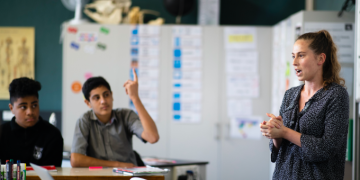Financial sustainability assessment for
Maths and statistics
Formative assessment is an ongoing process throughout teaching and learning. The assessment rubric can be downloaded, and learning outcomes can be highlighted or hyperlinked to evidence.







Level 4
Assess: Where am I? What am I doing? What do I do next?
Number and algebra achievement objective descriptors
Learners will use their mathematical knowledge and toolbox of strategies to solve a problem within a financial sustainability context. Problem-solving involves the learner finding out what works and what doesn’t, and clearly communicates the strategies and skills they have used to solve a problem.
|
In a range of meaningful contexts, students will be engaged in thinking mathematically and statistically. They will solve problems and model situations that require them to use a range of multiplicative strategies when operating on whole numbers. |
I am able to:
|
|
In a range of meaningful contexts, students will be engaged in thinking mathematically and statistically. They will solve problems and model situations that require them to understand addition and subtraction of fractions, decimals and integers. |
I am able to:
|
|
In a range of meaningful contexts, students will be engaged in thinking mathematically and statistically. They will solve problems and model situations that require them to find fractions, decimals, and percentages of amounts expressed as whole numbers, simple fractions and decimals. |
I am able to:
|
|
In a range of meaningful contexts, students will be engaged in thinking mathematically and statistically. They will solve problems and model situations that require them to apply simple linear proportions, including ordering fractions. |
I am able to:
|
|
In a range of meaningful contexts, students will be engaged in thinking mathematically and statistically. They will solve problems and model situations that require them to know the equivalent decimal and percentage forms for everyday fractions. |
I am able to:
|
|
In a range of meaningful contexts, students will be engaged in thinking mathematically and statistically. They will solve problems and model situations that require them to know the relative size and place value structure of positive and negative integers and decimals to three places. |
I am able to:
|
|
In a range of meaningful contexts, students will be engaged in thinking mathematically and statistically. They will solve problems and model situations that require them to form and solve simple linear equations. |
I am able to:
|
Measurement achievement objective descriptors
Learners will use their mathematical knowledge and toolbox of strategies to solve financial sustainability context problems. Problem-solving involves the learner finding out what works and what doesn’t, and clearly communicates the strategy and skills they used to solve a problem.
|
In a range of meaningful contexts, students will be engaged in thinking mathematically and statistically. They will solve problems and model situations that require them to convert between metric units, using whole numbers and commonly used decimals. |
I am able to:
|
|
In a range of meaningful contexts, students will be engaged in thinking mathematically and statistically. They will solve problems and model situations that require them to use side or edge lengths to find the perimeters and areas of rectangles, parallelograms and triangles, and the volumes of cuboids. |
I am able to:
|
Formative assessment
|
Where am I? What am I doing? What do I do next? |
Prestructural |
Unistructural |
Multistructural |
Relational |
Extended Abstract |
|---|---|---|---|---|---|
|
Investigate how financial planning can help people attain life goals.
Financial capability contexts include:
|
I can list short-term goals as part of a financial plan. |
I can list the benefits of short and long-term financial planning. |
I can investigate how financial planning can help people attain life goals, and can describe these goals. |
I can investigate how financial planning can help attain people life goals, and can explain the importance of financial planning at different stages of your life. |
I can investigate how financial planning can help people attain life goals, and create an overview for a possible financial plan throughout different stages. |
Level 5
Assess: Where am I? What am I doing? What do I do next?
Number and algebra achievement objective descriptors
Learners will use their mathematical knowledge and toolbox of strategies to solve financial sustainability context problems. Problem-solving involves the learner finding out what works and what doesn’t and clearly communicates the strategy and skills they used to solve the problem.
|
In a range of meaningful contexts, students will be engaged in thinking mathematically and statistically. They will solve problems and model situations that require them to reason with linear proportions.
|
I am able to:
|
|
In a range of meaningful contexts, students will be engaged in thinking mathematically and statistically. They will solve problems and model situations that require them to understand operations on fractions, decimals, percentages, and integers. |
I am able to:
|
|
In a range of meaningful contexts, students will be engaged in thinking mathematically and statistically. They will solve problems and model situations that require them to know commonly used fraction, decimal and percentage conversions. |
I am able to:
|
|
In a range of meaningful contexts, students will be engaged in thinking mathematically and statistically. They will solve problems and model situations that require them to use rates and ratios. |
I am able to:
|
|
In a range of meaningful contexts, students will be engaged in thinking mathematically and statistically. They will solve problems and model situations that require them to know and apply standard form, significant figures, rounding and decimal place value.
|
I am able to:
|
|
In a range of meaningful contexts, students will be engaged in thinking mathematically and statistically. They will solve problems and model situations that require them to form and solve linear and simple quadratic equations. |
I am able to:
|
Measurement achievement objective descriptors
Learners will use their mathematical knowledge and toolbox of strategies to solve financial sustainability context problems. Problem-solving involves the learner finding out what works and what doesn’t and clearly communicates the strategy and skills they used to solve the problem.
|
In a range of meaningful contexts, students will be engaged in thinking mathematically and statistically. They will solve problems and model situations that require them to select and use appropriate metric units for length, area, volume and capacity, weight (mass), temperature, angle, and time, with awareness that measurements are approximate. |
I am able to:
|
|
In a range of meaningful contexts, students will be engaged in thinking mathematically and statistically. They will solve problems and model situations that require them to convert between metric units, using decimals. |
I am able to:
|
|
In a range of meaningful contexts, students will be engaged in thinking mathematically and statistically. They will solve problems and model situations that require them to deduce and use formulae to find the perimeters and areas of polygons and the volumes of prisms |
I am able to:
|
|
In a range of meaningful contexts, students will be engaged in thinking mathematically and statistically. They will solve problems and model situations that require them to find the perimeters and areas of circles and composite shapes and the volumes of prisms, including cylinders. |
I am able to:
|
Formative assessment
|
Where am I? What am I doing? What do I do next? |
Prestructural |
Unistructural |
Multistructural |
Relational |
Extended Abstract |
|---|---|---|---|---|---|
|
Spending
Compare spending choices and priorities of individuals/whānau in relation to age and circumstance.
Financial capability contexts include:
|
I can only relate priorities and spending choices to my own situation. |
I can list spending choices and priorities of individuals and whānau in relation to age and circumstance, but they are not always relevant. |
I can compare spending choices and priorities of individuals/whānau in relation to age and circumstance at different stages of life, and describe what these are. |
I can compare spending choices and priorities individual/whānau in relation to age and circumstance, and can analyse these choices. |
I can compare spending choices and priorities of individuals/whānau in relation to age and circumstance, and can justify these choices. |
|
Credit and Debt
Different investment/whakangao product as a way of saving.
Financial capability contexts include:
|
I need help to understand that investment/whakangao is a means of saving.
|
I can list several different investment/whakangao products. |
I can describe different investment/whakangao products as a way of saving.
|
I can describe different investment/whakangao products as a way of saving and can explain how they work.
|
I can describe different investment/whakangao products as a way of saving and can explain how they work.
I can justify what investment/whakangao would be best at different stages of life.
|
|
Identifying and managing risk
Describe ways of managing risk involved in different investments/whakangao.
Financial capability contexts include:
|
I need help to identify possible investment/whakangao risks or can identify a risk for one type of investment/whakangao. |
I can identify risks but cannot discuss ways to manage these risks across different investments/whakangao.
|
I can describe several relevant ways of managing risk involved in different investments/whakangao.
|
I can describe investment/whakangao risks and explain how they can be managed to minimise potential loss over the time of an investment/whakangao. |
I can describe the risks of investments/whakangao and explain how they can be managed to minimise potential loss on an investment/whakangao I can reflect on potential risks of an investment/whakangao and can apply my knowledge to a given scenario.
|



Download PDF
Māori Medium Education
Written in te reo Māori with resources aligned to Te Marautanga o Te Aho Matua and Te Marautanga o Aotearoa.

















